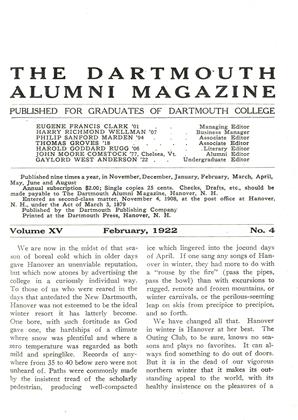Although some of the members of the management fraternity may affirm that no organization can be so charted as to show the various activities in their true relation except on a number of different planes, it would seem that the accompanying chart would be of some interest to the alumni to show the problem of administering Dartmouth College and what the real part of the alumnus is in its administration.
This chart is the result of a problem recently submitted to the class in "Organization and Management" and is representative of the good work that was turned m. It was selected because of its completeness and distinctive arrangement as well as neatness and appears in largely the same form as it was originally prepared, there having been only slight modification and amplification.
It likewise is of interest that Mr. Horstadius is one of the graduates of Swedish universities who have been doing graduate work in colleges of this country through the aid of scholarships given by the American-Scandinavian Foundation, the Swedish Board of Trade and the Royal Swedish Academy of Science. Last year, Mr. Waldemar Ekvall, a graduate of the University of Commerce of Stockholm, 1918, and an executive of the largest bank m Sweden, was here on the same basis and has since returned to Sweden, where he is now doing very effective work in advancing the ideas of modern management and is engaged in translating into Swedish some of the books of American authors on this subject.
This next semester, a mechanical engineer, a graduate of a technical school in Sweden, is coming to the Tuck School to take up special work in management.
Mr Horstadius was particularly interested in this problem of the organization of the College, since while attending the Royal Institute of Technology of Stockholm and after graduating in 1918, he was much interested in undergraduate activities. During his senior year he was president of the student body and secretary of the council of the united student bodies in Stockholm In 1919 he was reserve lieutenant in the Royal Engineers and for the year 1919-1920 was instructor in graphical statistics and the strength of materials at the Institute of Technology.
Every business enterprise or institution of any considerable size should have some method of .showing its organization, and indicating the assignment of duties to the different departments and personnel. For this purpose, it will be found very useful to draw up a chart of the organization, showing its different parts, the relation between them and all lines of authority and responsibility.
A college is an institution with an unusually complicated organization, since it has so many branches and activities, with a consequently large number of sources of authority. Therefore, it made an interesting problem to try to make a chart that might give information about it.
The problem of making such an organization chart of our college was given to the students of the Amos Tuck School and the chart presented in this number of the ALUMNI MAGAZINE is one of those submitted, later amplified and improved.
It is impossible to show everything on a chart like this, and the purpose has therefore been to give the most important features of the organization of the college and associated schools. The author has tried to keep departments, officers and activities of the same kind together as far as possible in order to facilitate the interpretation of the chart. Thus you will find, as the headings at the bottom and at the right-hand side indicate, that the alumni are grouped to the left, the college in the centre and the associated schools to the right: also that the Board of Trustees, the governing body, is shown at the top, followed by the officers, the students and the student activities. The relation between departments, committees and officers of different standings and so forth is indicated with solid lines, while the work of the standing committees of the faculty is signified with dotted lines.
This study has been of special interest to the author because of the opportunity to compare the organization of an American college with that of similar Swedish institutions, and it also will help when returning to Sweden in his desire to spread knowledge about the good features of American institutions.
At the same time, it is hoped that the publishing of the chart will be of value to anybody who is interested in or'has been connected with our college.
NATHANIEL G. BURLEIGH '11 Professor of Industrial Management, Amos Tuck School of Administration andFinance.
 View Full Issue
View Full Issue
More From This Issue
-
 Article
ArticleWe are now in the midst of that season
February 1922 -
 Article
ArticleOUTING CLUB CABINS AND TRAILS
February 1922 By I EUGENE FRANCIS CLARK '01 -
 Article
ArticleTHE DARTMOUTH OF THE FUTURE?
February 1922 By HARRY R. WELLMAN '07 -
 Article
ArticleTHE PLACE OF MENTAL HYGIENE AT DARTMOUTH
February 1922 By ARTHUR H. RUGGLES, M. D. '02 -
 Sports
SportsBASKETBALL
February 1922 -
 Books
BooksALUMNI PUBLICATIONS
February 1922 By L.S H.
NATHANIEL G. BURLEIGH '11
-
 Article
ArticleTHE IDEAL REUNION
January, 1923 By NATHANIEL G. BURLEIGH '11 -
 Article
ArticleDeath Ends Active Dartmouth Life
May 1937 By NATHANIEL G. BURLEIGH '11 -
 Books
BooksINTRODUCTION TO BUSINESS
March 1948 By Nathaniel G. Burleigh '11 -
 Class Notes
Class Notes1911 Has a Memorable 40th
July 1951 By NATHANIEL G. BURLEIGH '11 -
 Class Notes
Class Notes1911's "Best Ever" 45th
July 1955 By NATHANIEL G. BURLEIGH '11 -
 Class Notes
Class Notes1911's First Fiftieth
July 1961 By NATHANIEL G. BURLEIGH '11








